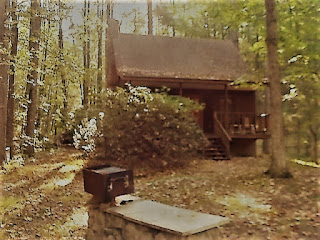Don’t get excited, John and I did not make a trip to Colorado
and climb a mountain, so maybe this posting will not be too interesting. However, John and I did enjoy ourselves on
this Ozark hill near Potosi, Missouri (about 60 miles from St. Louis) last week. John had read about this property, owned by
the Missouri Department of Conservation, in the book “Geologic Wonders and Curiosities of
Missouri” written by Thomas Beveridge. John
was intrigued by the fact that Missouri has one of four world-famous “scenic
examples of igneous rock which has cooled to form giant polygonal columns”. Hughes has one of the smaller examples of
this phenomenon, and it has been christened the Devil’s Honeycomb. It is a smaller group of columns than found
in the other three sites. ( By the way, John and I have seen one of those others,
Devils Tower National Monument in Wyoming. The other two are Devil's Post Pile National Monument in California and Giant's Causeway in Ireland.)
Once John learned that we have a site here in Missouri, he was ready to
go. Last Monday he mentioned making a
trip down to southeast Missouri, and after we quickly glanced at the weather
forecast for the week, we knew we had to go that day. Unfortunately, by the time we got going it
was well into the day, a fact which caused a bit of a problem later in the
waning hours of the afternoon.
This hike up the mountain was similar to the one we made
several weeks ago in Virginia. The
upward assent was about 400 feet, and the round trip total was about a mile and
a half. We encountered rocks and roots-
also the wet leaves were slippery, so we had to constantly watch where we were
placing our feet. We kept reminding each
other to be careful, the memory of John falling on our last hike was forefront
in my mind.
As we got closer to the top, John started pointing out to me
the fact that the rocks had certain geometric shapes to them- a polygonal
pattern meaning that they are four to 6 sided.
Like Elephant Rocks (another rocky scenic site in this part of Missouri)
the mountain here is composed of granite rock.
They are salmon pink, but colored yellow by lichens.
The mountain top view was wonderful, especially now that the
leaves are turning color.
Once we reached the top of the mountain, we found ourselves
on a very rocky surface bald with a
few grassy areas and short shrubs. We started wandering all over the surface at the top,
looking for the columns which were described in the book. What we found were shorter rows of rocks than
what I expected, they were 3 to 4 feet maximum height, having 4-6 sides.
We lost all track of time as we hiked all over the surface at the top. The sun was getting lower in the sky and we realized that we had to climb down very soon. However, there was no exit sign; we had to find the area where we had entered the top of the mountain. We wandered around rather aimlessly for about 30 minutes. For me, panic starting building as I realized that if either of us fell it would be a cold night on the mountain. No other humans had been seen the whole time we were there. John checked his phone, no service- we couldn't even call 911. John studied the trail map a bit more closely, and with the sun's help we got our directional bearings. We then saw a small trail sign pointing to the path which we needed to follow. Whew, that was the first time that ever happened to us in our wanderings. Hope we remember in the future to always pay attention to our surroundings. Maybe the whole problem lies with memory issues????







































